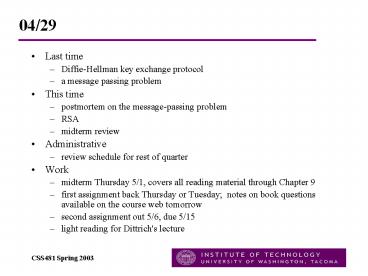Last time - PowerPoint PPT Presentation
1 / 12
Title:
Last time
Description:
postmortem on the message-passing problem. RSA. midterm review ... midterm Thursday 5/1, covers all reading material ... Postmortem on the Message ... – PowerPoint PPT presentation
Number of Views:46
Avg rating:3.0/5.0
Title: Last time
1
04/29
- Last time
- Diffie-Hellman key exchange protocol
- a message passing problem
- This time
- postmortem on the message-passing problem
- RSA
- midterm review
- Administrative
- review schedule for rest of quarter
- Work
- midterm Thursday 5/1, covers all reading material
through Chapter 9 - first assignment back Thursday or Tuesday notes
on book questions available on the course web
tomorrow - second assignment out 5/6, due 5/15
- light reading for Dittrich's lecture
2
Postmortem on the Message-Passing Problem
- The problem Alices were given a message and
told to send it to Bobs within an hour. - Eves were listening to all messages between
Alices and Bobs, and had 24 hours to decode - The result a message (of sorts) was sent, but
not decoded - Why the failure?
- What happened, and what could have happened to
make success more likely?
3
Pre-Midterm Reading
- Bishop Chapter 1 Overview
- Schneier, excerpts from Secrets and Lies
- Bishop, Chapter 2 Access control matrices
- Bishop, Chapter 4 Security Policies (overview)
- Bishop, Chapter 5 Confidentiality Policies
- skip 5.2.3, 5.2.4, 5.4
- Bishop, Chapter 6 Integrity Policies
- Bishop, Chapter 7 Hybrid Policies
- skip 7.1.2
- "Inside the Orange Book" chapter from Computer
Security - Bishop, Chapter 9 Basic Cryptography
- Two chapters from Crypto by Steven Levy "The
Standard" and "Public Key"
4
Bishop Chapter 1 Overview
- Basic components confidentiality, integrity,
availability - Threats disclosure, deception, disruption,
usurpation - Policy and mechanism
- Goals of security prevention, detection,
recovery - Trust and assurance
- Operational issues
- the role of cost-benefit analysis
- Human issues
5
Schneier Secrets and Lies
- Security as a property of a system
- Nature of attacks (why are attacks the same as
and different from security breach in
conventional systems) - Criminal, publicity, and legal attacks
- Knowing your adversaries motives and resources
- Security needs
- security versus integrity versus privacy versus
anonymity
6
Bishop Chapter 2 Access Control Matrix
- State of a system and protection state
- access control matrix describes a protection
state - Subjects, objects, and rights
- Control of access of aggregate properties (access
controlled by history) - Changes to the matrix attenuation of privilege
7
Bishop Chapter 4 Policies
- Definition of a security model, a security
policy, a secure system, and a security
mechanism - Definition of confidentiality, integrity, and
availability - Military versus commercial policies
- Types of access control discretionary versus
mandatory versus originator controlled - Policy languages high-level versus low-level
8
Bishop Chapter 5 Confidentiality Policies
- The goal of a confidentiality policy
- The Bell-LaPadula model
- preliminary version and full version
- The MAC system for mandatory access control
- Tranquility
9
Bishop Chapter 6 Integrity Policies
- Lipner's basic requirements, and justifications
for them - Basic principles
- separation of duty
- separation of function
- auditing
- The Biba integrity model
- low water mark, ring, strict model
- Lipner's implementation (Biba / Bell LaPadula
combo) - Clark-Wilson model (transactions, constrained
data items, integrity constraints)
10
Bishop Chapter 7 Hybrid Policies
- Chinese Wall model
- Clinical Information Systems security policy
- Originator Controlled access control
- Role-based access control
11
Inside the Orange Book
- Basic purpose of the book measurement,
guidance, acquisition - Four broad divisions of protection
- what are D, C, B, A, and what technology
distinguishes them - Trusted computing base
- Policy requirements discretionary access
control, object reuse, labels, mandatory access
control - Accountability requirements authentication,
trusted path, audit - Assurance requirements operational assurance,
life-cycle assurance - Documentation requirements
- Compartmented Mode Workstations
12
Bishop Chapter 9 Basic Cryptography
- Terms cryptosystem, plaintext, ciphertext
- Types of attacks ciphertext only, known
plaintext, chosen plaintext, adaptive plaintext - Transposition ciphers
- Substitution ciphers
- Vignere
- cracking substitution ciphers
- word frequencies, index of coincidence, Kasiski
method - one-time pad
- DES and AES
- Feistel ciphers, diffusion and confusion
- Public key Diffie-Hellman and RSA































